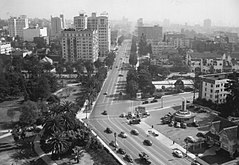Lafayette Park, Los Angeles
| Lafayette Park | |
|---|---|

Lafayette Park (left) in 1945; facing east.
|
|
| Type | Urban park |
| Location | Los Angeles, California, United States |
| Area | 35 acres |
| Created | 1899 |
| Operated by | City of Los Angeles Department of Recreation and Parks |
| Status | Open all year |
| Website | www |
Lafayette Recreation Center, also known as Lafayette Park, is a public park in the Westlake district of Los Angeles, California.
Clara R. Shatto donated 35 acres of land to the City of Los Angeles in 1899. The land consisted of tar seeps and oil wells and Shatto requested that it be developed into a park. Shatto was the wife of George Shatto, then-owner of Santa Catalina Island.
Canary Island palm trees and jacaranda were planted in the area of what became known as Sunset Park. Local groups requested that the name be changed to commemorate Marquis de Lafayette, a military officer of the American Revolutionary War. The name was officially changed in 1918. A statue of him was erected in 1937, close to the Wilshire Boulevard entrance.
A senior center designed by architect Graham Latta opened on the east side of the park in 1963. It was expanded by architect Stephen Kanner, whose firm improved the classrooms, community rooms, and gymnasium. In 2011, the Los Angeles Department of Recreation and Parks partnered with the non-profit organization Heart of Los Angeles (HOLA) to offer youth programs. The complex was renamed "Lafayette Park Recreation Center".
The park features sports facilities, including basketball courts; these were featured in the 1992 sports comedy, White Men Can't Jump, during which 20th Century Fox performed renovation. Also available for public use is the "Lafayette Skate Park".
The park's vicinity has seen the construction of numerous architecturally significant buildings. Several are listed in the National Register of Historic Places: the Sheraton Town-House, Felipe de Neve Branch Library, and Bullocks Wilshire, all built in 1929. Neighboring the park are also the First Congregational Church — an English Gothic Revival building completed in 1932 — and a 19-story glass building that houses a branch of the Los Angeles Superior Court (built in 1972).
...
Wikipedia
